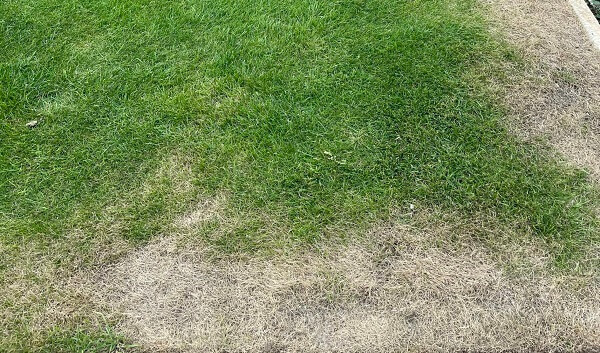Home / Information & advice / Turf & Lawns / Lawn aftercare / Helping your lawn to cope with drought
After a sustained period without water, grass plants will go dormant to conserve energy. While they are no longer actively growing, the leaves above ground may turn brown and crispy but the roots are very unlikely to die.
In the majority of cases, after rainfall, the grass plants will start to recover and within a few weeks be back to normal. The better maintained a lawn is, the longer it can withstand drought and the quicker it will recover.
However, for lawns severely impacted by drought the scars from water deprivation may be seen well into autumn. That makes now a good time to start planning some actions that can be considered to aid the lawns recovery.

Arid conditions can cause the ground beneath a lawn to become compacted. Baked hard by the long hot days and pressed down by lots of use by all the family, air and water are long gone which can make it a harsh environment that will slow recovery.
When rains return, water needs to be encouraged to drain through the soil but if lawns are hard-packed it will tend to run off. Therefore aerating by spiking should be considered.
Once the rain has made the topsoil soft enough to get a fork in, try spiking to a depth of around 8-10cm approximately 10-15cm apart.
Alternatively, you can use a mechanical aerator – and if hiring one, consider talking to friends and neighbours about clubbing together.
Our guide to decompaction and aeration has further details on this.
In drought conditions, lawns can often become depleted of the required nutrients for growth and as they start to grow again after rainfall quickly use up any remaining resources.
After one or two periods of rain, we suggest you plan to feed your lawn with a balanced autumn fertiliser. Aim to do this at least once during the September and October period. If possible, a second application before the end of autumn would probably be a good idea.
Follow our guide to fertilising your turf for advice on how to correctly apply fertiliser.
Rolawn’s GroRight® fertiliser offers a slow, steady release of fertiliser which is perfect for building up plant health over autumn, ahead of the additional stress of winter weather.
In late summer, plan some overseeding for early autumn. We recommend topdressing as part of your overseeding routine, and to make the task more affordable, suggest sharing a bulk bag of topdressing with someone local.
Click here for step-by-step overseeding advice.